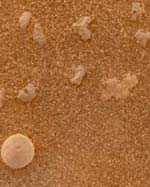
Image credit: NASA/JPL
This magnified look at the martian soil near the Mars Exploration Rover Opportunity’s landing site, Meridiani Planum, shows coarse grains sprinkled over a fine layer of sand. The image was captured by the rover’s microscopic imager on the 10th day, or sol, of its mission and roughly approximates the color a human eye would see. Scientists are intrigued by the perfectly round pebbles, which most likely were formed by one of two geologic processes. The first, accretion, is the same mechanism by which pearls take shape in oysters: concentric layers of material build up around a “seed.” The seed, in this case, may be either waterborne particles or volcanic ash. In the second process, droplets of material are sprayed into the air, by either volcanic eruptions or asteroid impacts. The examined patch of soil is 3 centimeters (1.2 inches) across. The large, circular pebble in the lower left corner is approximately 3 millimeters (.12 inches) across, or about the size of a sunflower seed. This color composite was obtained by merging images acquired with the orange-tinted dust cover in both its open and closed positions. The blue tint at the lower right corner is a tag used by scientists to indicate that the dust cover is closed.
Original Source: NASA/JPL News Release
